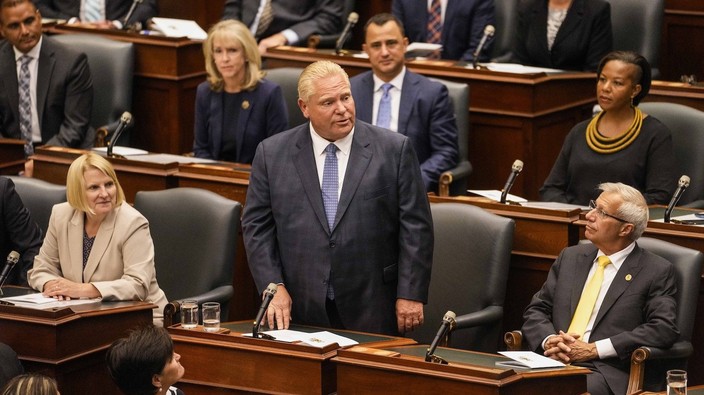five things experts say could ease pressures on ontario’s health-care system
the canadian press asked experts and advocates what they suggest to provide relief to ontario’s overburdened health system. these are the five solutions they proposed.

doug ford speaks after lt.-gov. elizabeth dowdeswell delivered her speech from the throne at queen's park in toronto, on tuesday, august 9, 2022. the premier has acknowledged that more can be done to ease health system pressures in ontario. the canadian press/andrew lahodynskyj
temporary emergency room closures and increased wait times have become increasingly common in ontario as the province’s health-care system grapples with staffing shortages. premier doug ford has acknowledged that more can be done to ease health-system pressures, but his throne speech this week fell short of offering solutions to the problem.
the canadian press asked experts and advocates what they suggest to provide relief to ontario’s overburdened health system. here are five solutions they proposed:
1. repeal bill 124
scrapping the law known as bill 124 — which caps wage increases for public sector contracts at one per cent a year for three years — is top of the list for the registered nurses’ association of ontario.
doris grinspun, the association’s ceo, said the law needs to be repealed to ensure nurses are adequately compensated for their work, which would encourage them to stay in the profession. she pointed to the rising cost of living in calling for higher wages.
dr. michael warner, an intensive care physician at toronto’s michael garron hospital, warned keeping the law in place could spur more public sector health-care workers to jump ship for private agencies, where they could earn more.
advertisement
“(bill 124) makes nurses and other public sector health workers who are subjected to this legislation feel devalued and it puts them in a position where they have minimal negotiation leverage, because there’s a cap on their pay increase,” he said.
“though money is not the only thing, we’ve seen a migration of nurses, in particular from publicly funded hospital positions that are unionized, to private agency work.”
the premier has noted that the provisions in bill 124 expire and won’t apply to the next contract negotiations, but has not said he would repeal the law.
2. train, register more workers
experts say more people need to be registered and trained to work in health care to lighten the workloads of those currently in the sector.
last week, ontario’s health minister directed regulatory colleges for nurses and doctors to develop plans to more quickly register internationally educated professionals.
but grinspun, of the rnao, said she’s waiting to see what those plans entail and how quickly they fast-track the process, noting that the number of nurses “waiting on the sidelines” to be registered sits around 26,000. “the backlog needs to be dealt with immediately,” she said.
abi sriharan, assistant professor at the university of toronto’s institute of health policy, management & evaluation, said canada should have a standardized accreditation system. that would allow any doctor or nurse that wants to work in ontario to easily make the transition without going through a lengthy and often expensive licensing process, sriharan said.
advertisement
the rnao is also calling on the government to increase funding for additional seats in university and college nursing programs. grinspun said that would help accommodate the 35 per cent increase in applicants for the program that produces registered nurses and 70 per cent increase in applicants for the nurse practitioner program.
3. build standalone centres to catch up on surgical backlog
ontario should build publicly funded, standalone health centres that can perform less complex outpatient surgeries and procedures, said dr. rose zacharias, president of the ontario medical association and an emergency department physician.
this would free up beds and other resources in hospitals, which zacharias said would result in shorter patient wait times and allow the province to catch up on its backlog of surgeries and procedures.
over the course of the pandemic, she said 22 million patient services were delayed, 10 million of which were surgeries and cancer screening procedures. that’s contributing to the “strain” that is being felt in emergency departments, she said.
“we need these facilities and we are recommending that a series of these facilities be built across the province in order to manage the backlog,” said zacharias.
advertisement
4. improve work conditions for staff
burnout among health-care workers, and the conditions that contribute to it, need to be addressed, experts say.
grinspun, of the rnao, said nurses face “brutal” workloads, and having more staff is key to fixing the problem. mental health support, mentorship and good leadership will in turn aid retention, she added, as nurses contend with nearly three years of pandemic exhaustion.
“having the support is helpful at all times, even more so during this time,” she said.
sriharan, a health systems leadership expert at the university of toronto, said mental health resources for burnt-out workers will only be “band-aid solutions” if the environment that caused the problem doesn’t also change.
it’s important to speak with health-care workers to understand what’s causing burnout in each organization and make appropriate changes, she said.
5. implement a system to track, prevent staff shortages
experts say a national system is also needed to track staffing levels at different health-care institutions to ensure that there is a balanced distribution of the workforce and prevent service disruptions.
“in certain areas, we have a lot of people and then a lot more areas, we don’t have the optimum capacity, so we don’t have enough primary care physicians, we don’t have nurses who can function at the level that we need service,” said sriharan, of the university of toronto’s institute of health policy, management & evaluation.
advertisement
zacharias, of the ontario medical association, said a tracking system is also needed to monitor staff shortages inside health-care teams.
“we have been operating on hunches and anecdotes and we need the clear data.”
thank you for your support. if you liked this story, please send it to a friend. every share counts.
 4 minute read
4 minute read





